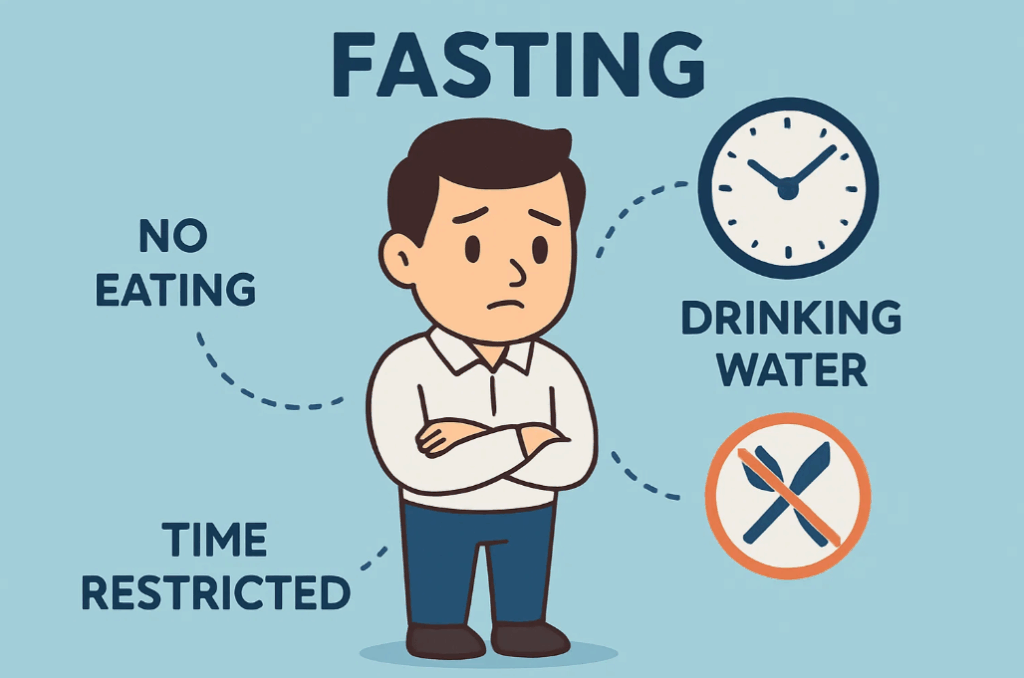Fasting has gained widespread attention in recent years, not just as a weight-loss method, but as a powerful approach to improving overall health. Modern research is revealing a range of health benefits linked to controlled periods of not eating, including improved blood sugar regulation, reduced inflammation, enhanced cellular repair, and better brain function. Whether through intermittent fasting, time-restricted eating, or extended fasts, many people are turning to this simple, structured approach as a way to boost energy, support metabolic health, and promote longevity. In this article, we explore the science-backed health benefits of fasting and its growing role in preventive wellness.
Why Fasting is So Good for You
Fasting, the voluntary abstinence from food or drink for a set period, has been practiced for centuries across cultures and religions. Modern science has begun to uncover why this practice is so beneficial, revealing its impact on physical, mental, and emotional health. Below are some of the key reasons fasting is so good for you:
1. Promotes Cellular Repair and Autophagy
One of the most remarkable benefits of fasting is its ability to trigger autophagy, a natural process where cells clean out damaged components and recycle them for energy. This cellular “housekeeping” is crucial for maintaining healthy cells and preventing diseases like cancer and Alzheimer’s. During fasting, the body shifts from using glucose for energy to burning stored fat, which prompts autophagy. Studies, such as those published in Cell Metabolism (2018), have shown that autophagy is significantly enhanced during periods of prolonged fasting, typically after 12–16 hours without food.
2. Improves Metabolic Health
Fasting can significantly improve metabolic markers such as insulin sensitivity, blood sugar levels, and cholesterol profiles. When you fast, insulin levels drop, allowing the body to access stored fat for energy. This can reduce the risk of type 2 diabetes and obesity. A 2019 study in The New England Journal of Medicine found that intermittent fasting improved insulin sensitivity and reduced blood pressure in participants with metabolic syndrome.
3. Supports Weight Loss and Fat Burning
Fasting is an effective strategy for weight loss because it creates a calorie deficit while preserving muscle mass. During fasting, the body taps into fat stores for energy, especially during extended fasts or intermittent fasting protocols. Research from Obesity Reviews (2020) indicates that intermittent fasting is as effective as traditional calorie restriction for weight loss but may be easier to sustain for some individuals due to its flexibility.
4. Enhances Brain Function
Fasting has profound effects on brain health. It increases the production of brain-derived neurotrophic factor (BDNF), a protein that supports neuron growth and protects against neurodegenerative diseases. Fasting also reduces inflammation and oxidative stress in the brain, which can improve cognitive function and mood. A 2017 study in Neuroscience Letters showed that fasting improved memory and focus in animal models, with similar effects observed in humans practicing intermittent fasting.
5. Boosts Longevity
Fasting has been linked to increased lifespan in various studies, particularly in animal models. By reducing oxidative stress, improving metabolic health, and promoting autophagy, fasting may slow the aging process. A 2018 study in Nature Communications found that fasting-mimicking diets extended lifespan in mice by reducing age-related diseases. While human studies are ongoing, the evidence suggests that fasting could promote healthier aging.
6. Improves Gut Health
Fasting gives the digestive system a break, allowing the gut to repair and rebalance its microbiome. This can reduce inflammation, improve digestion, and enhance nutrient absorption. A 2021 study in Frontiers in Microbiology found that fasting promotes a healthier gut microbiome by increasing microbial diversity, which is essential for overall health.
7. Enhances Mental Clarity and Discipline
Beyond physical benefits, fasting fosters mental clarity and emotional resilience. The discipline required to fast can strengthen willpower and mindfulness, helping individuals develop a healthier relationship with food. Many people report feeling more focused and energized during fasting periods, likely due to the stabilization of blood sugar levels and the production of ketones, which provide a steady energy source for the brain.
What Fasting Looks Like
Fasting can take many forms, depending on individual goals, lifestyles, and health conditions. Below are some common fasting methods and what they entail:
1. Intermittent Fasting (IF)
Intermittent fasting involves cycling between periods of eating and fasting. Popular protocols include:
- 16/8 Method: Fast for 16 hours and eat within an 8-hour window (e.g., eating between 10 AM and 6 PM).
- 5:2 Diet: Eat normally for five days a week and restrict calorie intake to 500–600 calories on two non-consecutive days.
- Alternate-Day Fasting: Alternate between fasting days (no food or very low calories) and eating days.
What it looks like: For the 16/8 method, you might skip breakfast, have your first meal at noon, and finish eating by 8 PM. During the fasting period, you can consume water, black coffee, or unsweetened tea.
2. Extended Fasting
Extended fasting involves fasting for 24 hours or more, often for 1–3 days. This is typically done less frequently, such as once a month, and requires careful preparation.
What it looks like: During a 24-hour fast, you might stop eating after dinner one day and not eat again until dinner the next day. Hydration is critical, and electrolyte supplements (like sodium, potassium, and magnesium) may be needed to prevent imbalances.
3. Time-Restricted Eating
This is a milder form of intermittent fasting where eating is confined to a specific time window each day, typically 10–12 hours. It aligns with the body’s circadian rhythm, promoting better sleep and digestion.
What it looks like: You might eat all meals between 8 AM and 6 PM, fasting overnight for 14 hours.
4. Religious or Cultural Fasting
Many religions incorporate fasting, such as Ramadan (daily fasting from dawn to dusk for a month) or Yom Kippur (a 25-hour fast). These fasts often combine spiritual goals with physical benefits.
What it looks like: During Ramadan, Muslims abstain from food and drink from sunrise to sunset, breaking their fast with a meal called Iftar, often starting with dates and water.
Tips for Fasting Successfully
Fasting can be challenging, especially for beginners, but with the right approach, it can be safe and rewarding. Here are practical tips to ensure success:
1. Start Slowly
If you’re new to fasting, begin with a shorter fasting window, such as 12 hours, and gradually increase it. For example, try time-restricted eating before progressing to a 16/8 intermittent fasting schedule.
2. Stay Hydrated
Dehydration is a common issue during fasting, especially during extended fasts. Drink plenty of water throughout the day, and consider adding a pinch of high-quality salt (like Himalayan pink salt) to maintain electrolyte balance. Herbal teas and black coffee (without sugar or cream) are also great options.
3. Listen to Your Body
Fasting is not one-size-fits-all. Pay attention to how your body responds, and stop if you feel dizzy, weak, or unwell. Consult a healthcare professional before starting, especially if you have medical conditions like diabetes or are pregnant.
4. Plan Nutrient-Dense Meals
When breaking a fast, prioritize nutrient-dense foods to replenish your body. Avoid overeating or consuming processed foods, as this can negate fasting’s benefits. Focus on whole foods like vegetables, lean proteins, healthy fats, and complex carbohydrates.
5. Manage Hunger
Hunger pangs are normal, especially in the early stages of fasting. Distract yourself with light activities, such as walking or reading, and drink water to curb hunger. Over time, your body will adapt, and hunger will diminish.
6. Time Your Workouts
Exercise can complement fasting, but timing matters. For shorter fasts, working out just before breaking your fast can enhance fat burning. For extended fasts, stick to light activities like yoga or walking to avoid overexertion.
7. Break Your Fast Gently
After a fast, especially an extended one, reintroduce food gradually to avoid digestive discomfort. Start with small portions of easily digestible foods, such as bone broth, yogurt, or cooked vegetables, before moving to larger meals.
8. Stay Consistent
Consistency is key to reaping fasting’s benefits. Choose a fasting schedule that fits your lifestyle and stick to it. Over time, fasting becomes easier as your body adapts.
Transitioning to Healthy Eating Post-Fast
Breaking a fast properly and maintaining a healthy diet afterward are critical to sustaining the benefits of fasting. Here’s how to eat healthily post-fast:
1. Focus on Whole, Nutrient-Dense Foods
Incorporate a variety of whole foods to nourish your body:
- Vegetables: Leafy greens, broccoli, carrots, and bell peppers provide vitamins, minerals, and fiber.
- Lean Proteins: Eggs, chicken, fish, tofu, and legumes support muscle repair and satiety.
- Healthy Fats: Avocados, nuts, seeds, and olive oil provide energy and support brain health.
- Complex Carbohydrates: Quinoa, sweet potatoes, and whole grains offer sustained energy without spiking blood sugar.
2. Avoid Processed Foods
Processed foods, high in sugar, refined carbs, and unhealthy fats, can cause inflammation and undo fasting’s benefits. Limit fast food, sugary snacks, and sodas, and opt for homemade meals whenever possible.
3. Practice Portion Control
After fasting, it’s tempting to overeat, but this can strain your digestive system. Use smaller plates, chew slowly, and stop eating when you’re 80% full to avoid discomfort.
4. Prioritize Gut Health
Support your gut microbiome with fermented foods like yogurt, kefir, sauerkraut, and kimchi. Prebiotic foods, such as garlic, onions, and bananas, also promote healthy gut bacteria.
5. Stay Hydrated
Continue drinking plenty of water post-fast to support digestion and overall health. Aim for at least 8–10 cups daily, adjusting based on activity level and climate.
6. Plan Balanced Meals
A balanced meal includes a mix of protein, fat, and carbs. For example:
- Breakfast: Greek yogurt with berries, chia seeds, and a drizzle of honey.
- Lunch: Grilled chicken salad with mixed greens, avocado, olive oil, and balsamic vinegar.
- Dinner: Baked salmon with quinoa and steamed broccoli.
Sample Post-Fast Meal Plan
Here’s a sample one-day meal plan for breaking a 16-hour fast:
- 12 PM (Break Fast): Bone broth with a small serving of cooked spinach and a boiled egg.
- 3 PM: Grilled chicken breast, roasted sweet potato wedges, and a side of sautéed kale.
- 6 PM: Baked cod with quinoa, steamed asparagus, and a mixed green salad with olive oil dressing.
- Snack (if needed): A handful of almonds and an apple.



